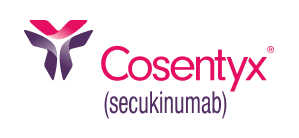
For your adult patients with PsO at risk for developing PsA
The largest number of patients studied among IL antagonists1*
Nadia, actual patient with PsO on COSENTYX®, and Gary, actual patient with PsO and PsA on COSENTYX, were compensated for their time. Individual results may vary.
Trust in the well-studied clinical profile
~90 completed studies and >74,000 patients2
.
 NO Boxed WARNING3
NO Boxed WARNING3 NO warning for suicidal ideation and behavior3
NO warning for suicidal ideation and behavior3COSENTYX PsO trials did not screen out patients with depression or suicidal ideation4-8†
 NO routine lab monitoring, including liver enzymes, during treatment3
NO routine lab monitoring, including liver enzymes, during treatment3Evaluate patients for TB prior to initiating treatment
 NO trend toward increased AE incidence rates of Candida infections, IBD, MACE, or malignancy through Year 59
NO trend toward increased AE incidence rates of Candida infections, IBD, MACE, or malignancy through Year 59 <1% of patients had immunogenicity over 5 years10
<1% of patients had immunogenicity over 5 years10Neutralizing antibodies developed in 0.6% of patients with PsO and were not associated with loss of efficacy‡
†Protocol permitted investigator discretion to exclude any individuals with any medical or psychiatric condition that, in the investigator's opinion, would preclude the patient from adhering to the protocol or completing the study.4-8
‡The detection of antibody formation is highly dependent on the sensitivity and specificity of the assay.3
An established clinical profile3
Pooled PsO safety in pivotal trials in adults through Week 12 | ||
AEs >1% in ERASURE, FIXTURE, FEATURE, JUNCTURE | COSENTYX 300 mg (n=691) | Placebo (n=694) |
Nasopharyngitis | 11.4% | 8.6% |
Diarrhea | 4.1% | 1.4% |
URTI | 2.5% | 0.7% |
Rhinitis | 1.4% | 0.7% |
Oral herpes | 1.3% | 0.3% |
Pharyngitis | 1.2% | 0.0% |
Urticaria | 0.6% | 0.1% |
Rhinorrhea | 1.2% | 0.1% |
No new cases of CD and 3 cases of exacerbation (in which 1 patient received COSENTYX); 2 new cases of UC and 2 cases of exacerbation; no cases of IBD in patients with placebo
29% of patients experienced infections (n=1382) vs 19% with placebo (n=694)
0.1% of patients reported serious infections (n=1382) vs 0.3% with placebo (n=694)
If a serious infection develops, discontinue COSENTYX until the infection resolves
A robust long-term safety profile9
PsO safety data from the 5-year uncontrolled SCULPTURE extension study in adults
Treatment-emergent AEs 300 mg (FI) (EAIR per 100 patient-years)§ | Year 1 | Year 2 to Year 5 | |||
| n=168 | n=168 | n=157 | n=142 | n=134 |
Most frequent AEs | |||||
Nasopharyngitis | 20.1 | 18.1 | 18.8 | 13.5 | 11.1 |
Hypertension | 6.8 | 5.1 | 2.0 | 5.3 | 3.6 |
Back pain | 4.3 | 5.7 | 6.2 | 2.2 | 2.1 |
URTI | 7.5 | 7.1 | 3.5 | 3.8 | 3.6 |
Headache | 6.2 | 4.4 | 2.7 | 2.2 | 0.7 |
Selected AEs | |||||
Opportunistic infections (other than TB and candidiasis) | 0.0 | 0.0 | 0.0 | 0.0 | 0.0 |
Tuberculosis | 0.0 | 0.0 | 0.0 | 0.0 | 0.0 |
Candida infections |
|
|
|
|
|
| 1.8 | 1.9 | 0.7 | 0.0 | 0.0 |
| 0.0 | 0.6 | 0.0 | 0.7 | 0.0 |
Neutropenia|| | 0.0 | 0.0 | 0.0 | 0.0 | 0.0 |
MACE | 0.0 | 0.0 | 0.0 | 0.7 | 0.7 |
Inflammatory bowel disease |
|
|
|
|
|
| 0.0 | 0.0 | 0.0 | 0.0 | 0.0 |
| 0.0 | 1.2¶ | 0.7 | 0.0 | 0.0 |
Malignant or unspecified tumors (excluding NMSC) | 0.0 | 1.2# | 0.0 | 0.0 | 0.7** |
Safety data up to Year 1 based on a post hoc analysis of the SCULPTURE core study in patients treated with 300 mg who achieved PASI 75 at Week 12, who were rerandomized to 300-mg FI arm, and reconsented at Week 52 to enter the SCULPTURE extension study. Year 2 to Year 5 safety data are presented in this same patient subpopulation; thus, not all patients who started with 300 mg in the SCULPTURE core study were included.
§Patient exposure is calculated as a sum of individual subject durations in days divided by 365 for each interval. A patient with multiple occurrences of the same AE in a 1-year interval was counted only once, while a patient with multiple occurrences of the same AE in different-year intervals was counted for each year.7
||Includes neutropenia adverse events reported by investigators in the SCULPTURE study; does not include lab reports of neutropenia.7
¶Of the 2 cases of UC in Year 2, 1 case was an exacerbation of previously existing UC.
#1 case of cholangiocarcinoma, 1 case of invasive ductal breast carcinoma.
**1 case of breast cancer.
Definitions
AE, adverse event; CD, Crohn’s disease; EAIR, exposure-adjusted incidence rate (patient incidence rate per 100 patient-years); FI, fixed interval; IBD, inflammatory bowel disease; IL, interleukin; MACE, major adverse cardiovascular event; NMSC, nonmelanoma skin cancer; PASI, Psoriasis Area and Severity Index; PsA, psoriatic arthritis; PsO, plaque psoriasis; TB, tuberculosis; UC, ulcerative colitis; URTI, upper respiratory tract infection.
References
1. Data on file. Summary of Approved IL Antagonist Trials. Novartis Pharmaceuticals Corp; March 2025.
2. ClinicalTrials.gov. Accessed October 10, 2024. https://clinicaltrials.gov/search?term=Secukinumab&aggFilters=status:com&limit=100&viewType=Table
3. Cosentyx. Prescribing information. Novartis Pharmaceuticals Corp.
4. Blauvelt A, Prinz JC, Gottlieb AB, et al; for the FEATURE Study Group. Secukinumab administration by pre-filled syringe: efficacy, safety, and usability results from a randomized controlled trial in psoriasis (FEATURE). Br J Dermatol. 2015;172(2)(suppl):1-20.
5. Data on file. AIN457A2302 (ERASURE): Clinical Trial Protocol. Novartis Pharmaceuticals Corp; February 2011.
6. Data on file. AIN457A2303 (FIXTURE): Clinical Trial Protocol. Novartis Pharmaceuticals Corp; February 2011.
7. Data on file. CAIN457A2304 (SCULPTURE): Clinical Study Report. Novartis Pharmaceuticals Corp; September 2013.
8. Data on file. CAIN457A2309 (JUNCTURE): Clinical Study Report. Novartis Pharmaceuticals Corp; November 2014.
9. Bissonnette R, Luger T, Thaçi D, et al. Secukinumab demonstrates high sustained efficacy and a favourable safety profile in patients with moderate-to-severe psoriasis through 5 years of treatment (SCULPTURE Extension Study). J Eur Acad Dermatol Venereol. 2018;32(9):1507-1514.
10. Reich K, Blauvelt A, Armstrong A, et al. Secukinumab, a fully human anti interleukin-17A monoclonal antibody, exhibits low immunogenicity in psoriasis patients treated up to 5 years. J Eur Acad Dermatol Venereol. 2019;33(9):1733-1741.
